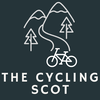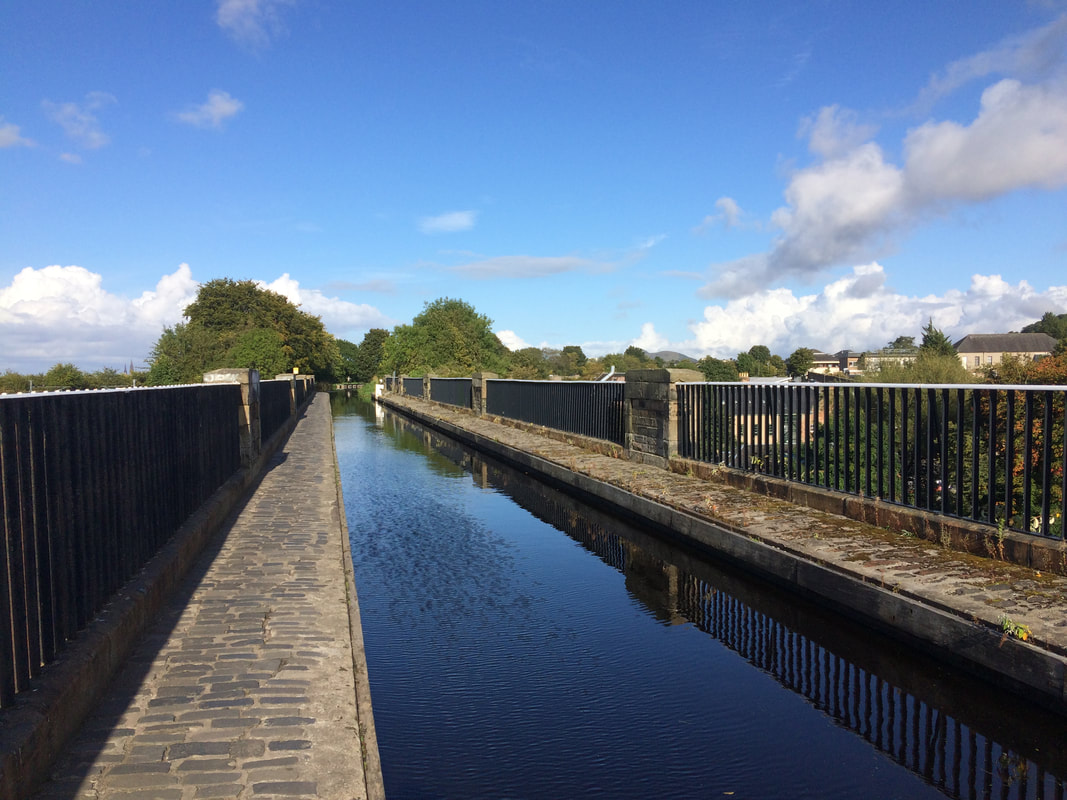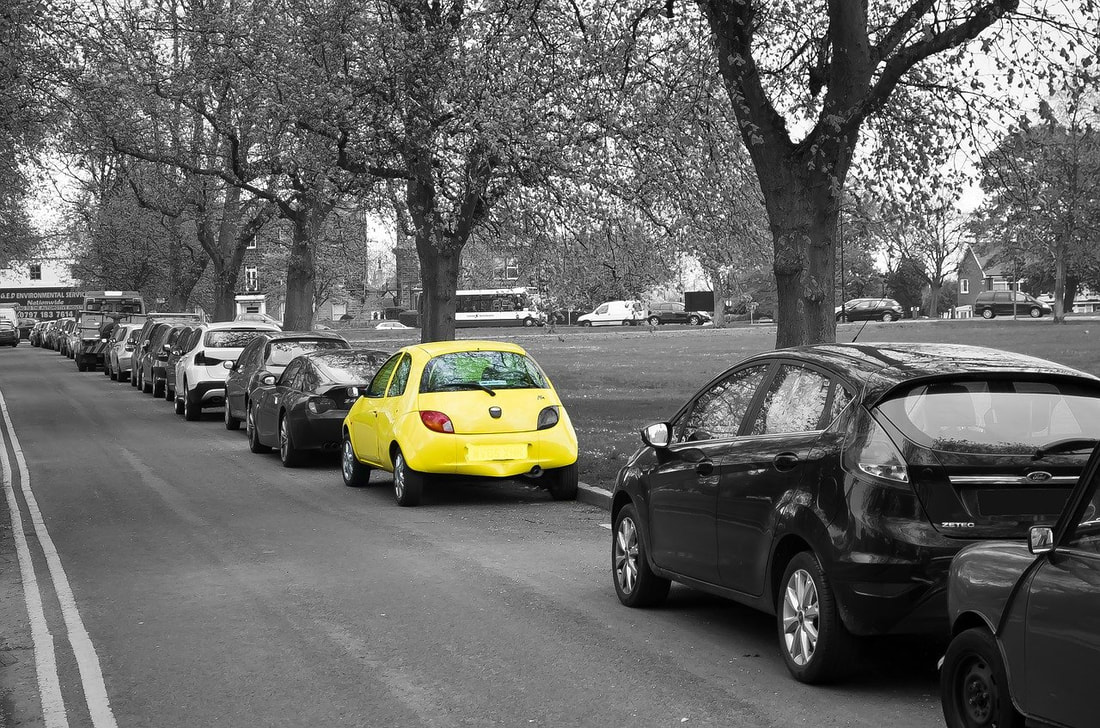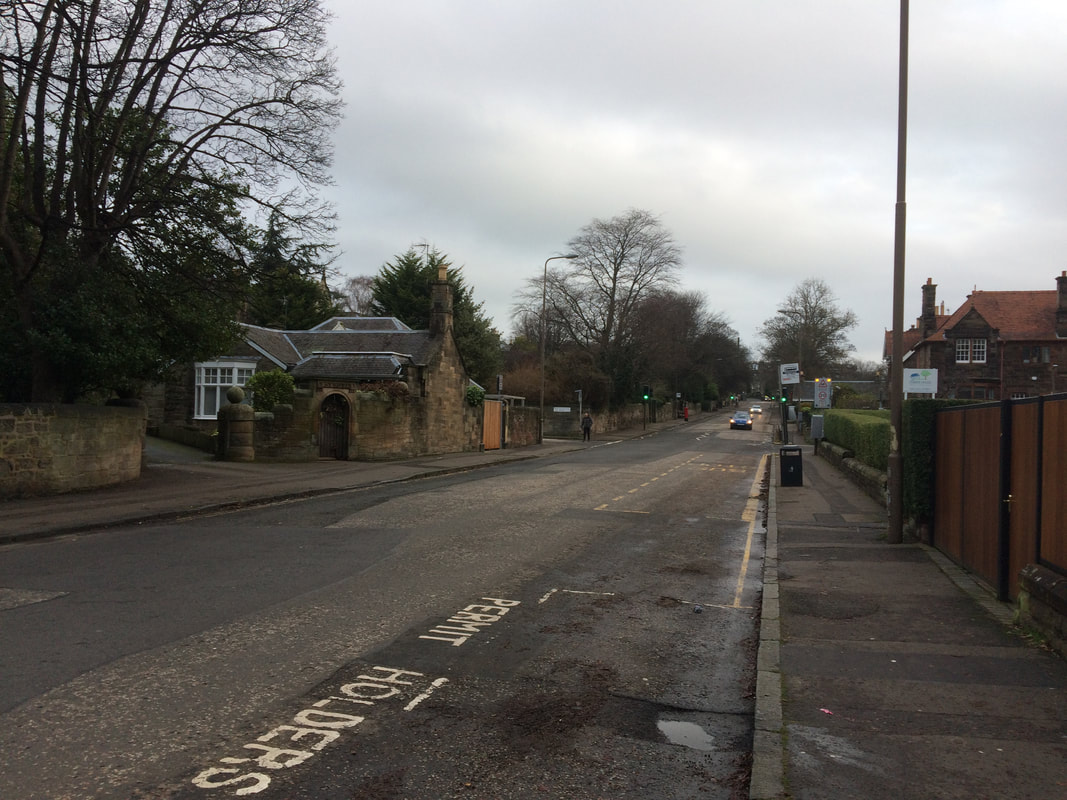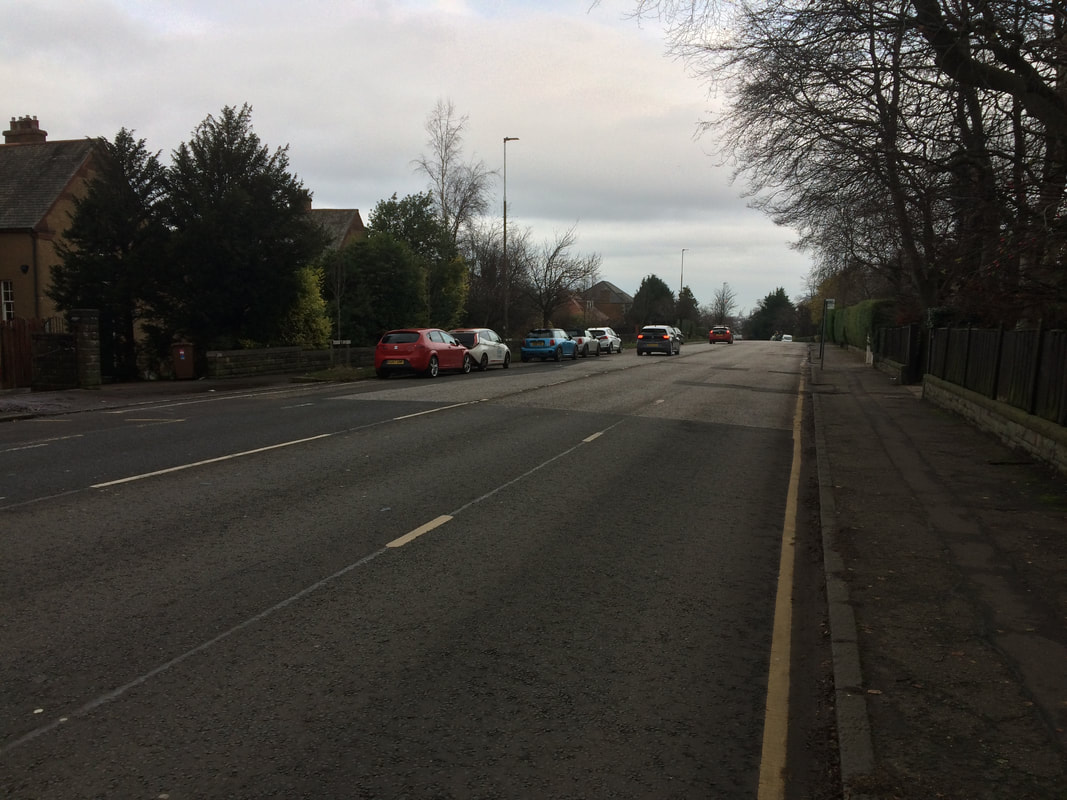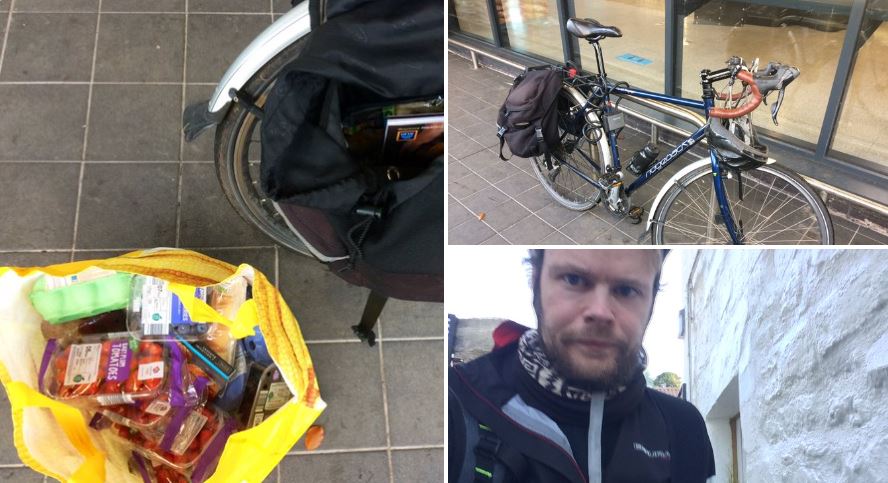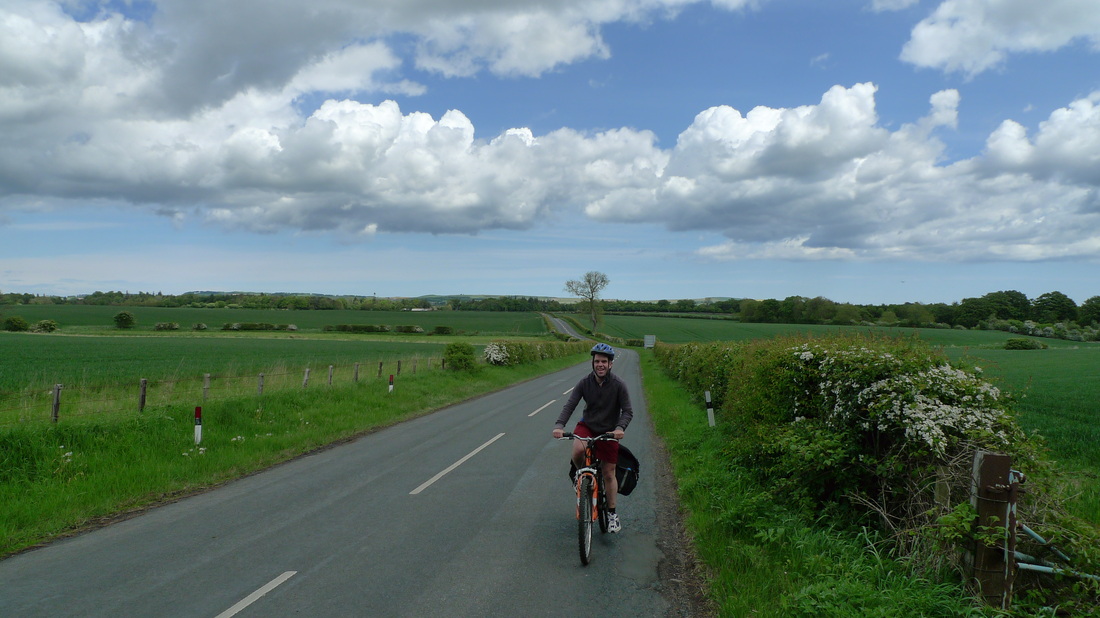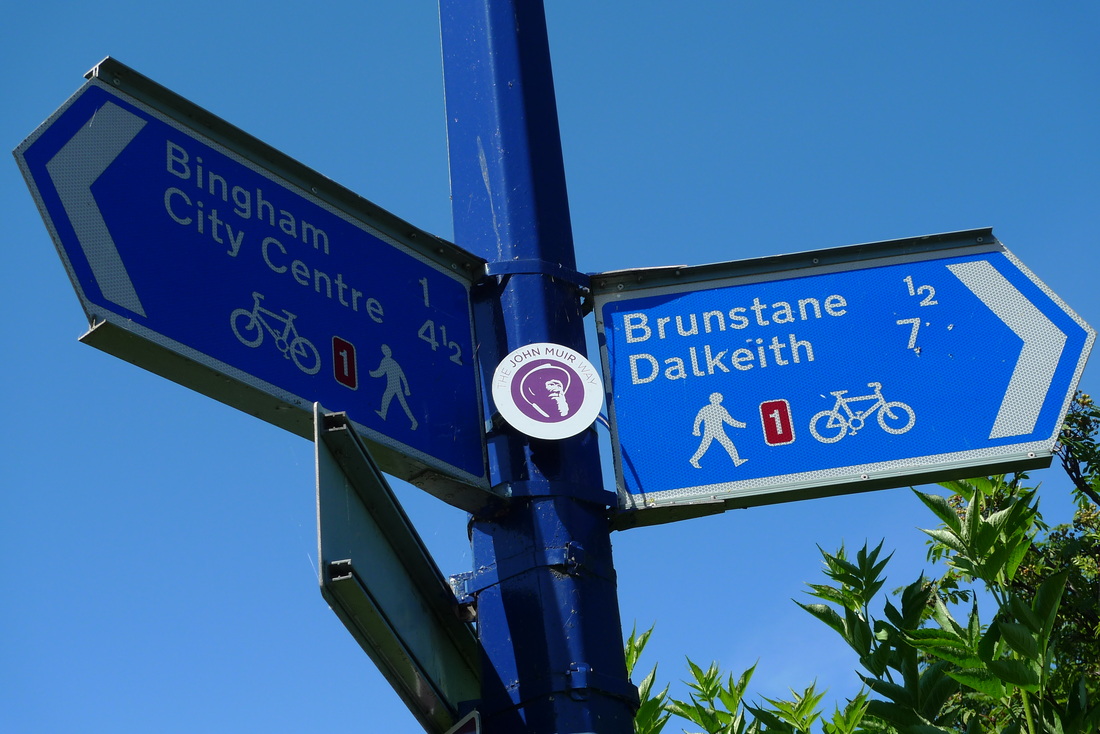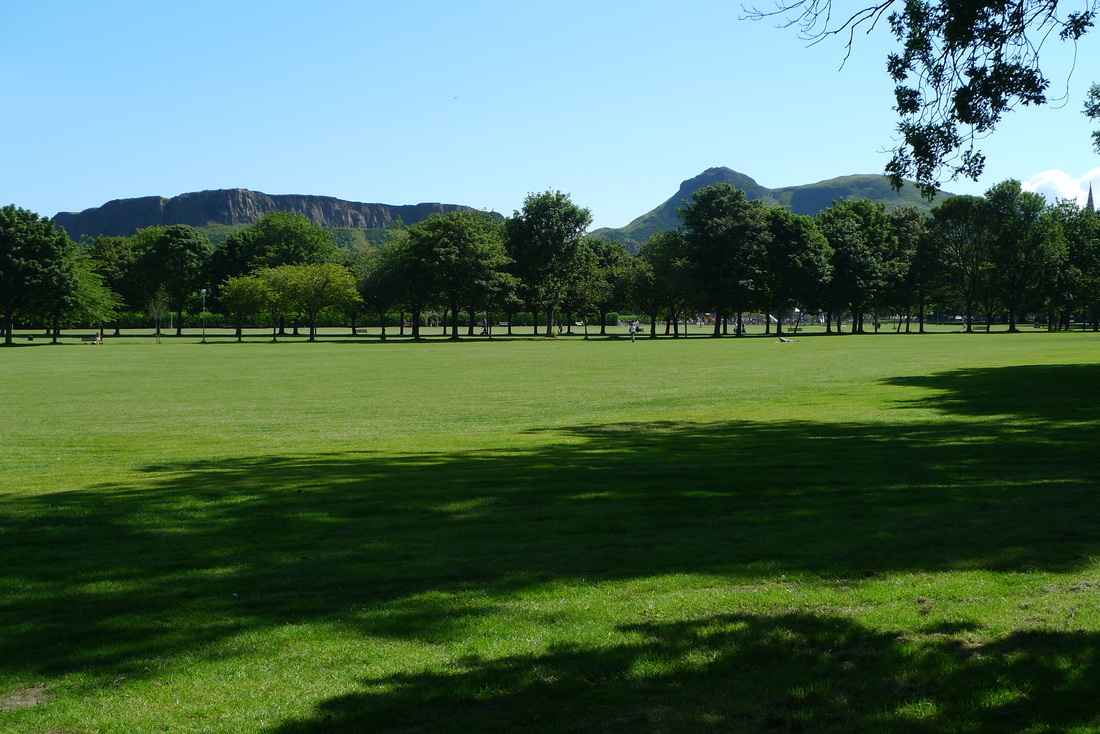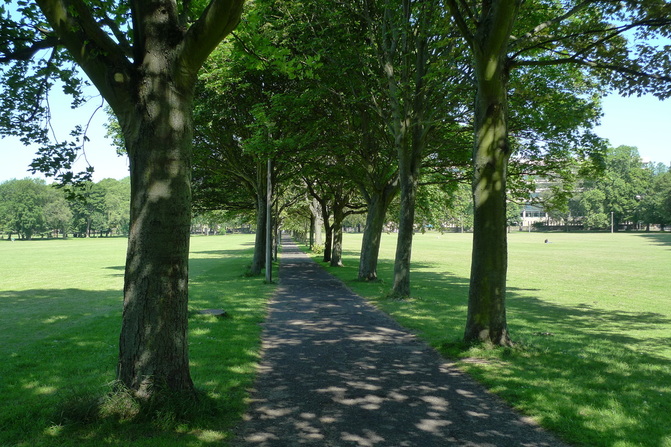|
The Union Canal path is one of Edinburgh's primary traffic-free cycle routes. It can be the ideal way to reach various parts of the city whilst avoiding motor traffic. However, I don't always use it because of a number of issues that I will discuss in this blog. These issues highlight why the Union Canal cannot always be a part of the solution to providing segregated cycling infrastructure for everyday journeys.
In a previous blog I wrote about my cycle commute using Colinton Road. The Union Canal path follows much of this road and it provides a traffic-free alternative, but I don't always find that it works for me and this is why: 1. Poor access onto the canal If you are lucky enough to live right next to, or very close to the canal path then its easy to get on it. My closest access point is via the disused railway path that travels through the famous Colinton Tunnel. This railway path goes through Colinton Dell, alongside the Water of Leith and is a beautiful place for a leisure bike ride. However, for most of the winter months it is a muddy mess that is difficult and inconvenient to cycle through, particularly if you need to get somewhere in good time and you really do not want your bike to be messed up by all that mud. I can use another access point just off Craiglockhart Road North and this avoids the muddy path. However, to get to Craiglockhart Road North you need to cycle on Colinton Road, which can be busy with traffic. You can avoid some of Colinton Road by taking the quieter roads through the housing streets of Craiglockhart, but it is convoluted, takes longer and it involves trying to cross over the busy Craiglockhart Avenue. Once you reach the canal access point you will find that there are steps. That's okay for some, but not everyone will manage to get their bike down these steps. 2. Slateford Viaduct If I do access the canal from the disused railway path I will come across one of the canal's main pinch points, the Slateford Viaduct. This has an extremely narrow cobblestone path. The signage here states that you should not cycle on it and walk across with your bike, although some people do cycle it. It is too narrow for people travelling in opposite directions to pass each other without one person coming to a complete stop and pulling right into the edge. There is always a feeling that someone is going to fall into the water. Crossing the viaduct a few times a year for a leisure trip along the canal can be a novelty, but for everyday cycling for commuting or other purposes it is inconvenient and slows down the journey time. 3. Blind spots when cycling under bridges When cycling on the Union Canal there are a large number of bridges that the path passes beneath. Many of these are pinch points with a blind spot that means you cannot see if there is another person approaching in the opposite direction. A collision is likely without the use of a bicycle bell. Not every person that uses the canal has a bell on their bike and some people might not hear it if they are listening to music. I slow right down at these bridges because of the risk of a collision, but I have seen many people on bicycles going too fast. The path under some of these bridges narrows and some have cobblestones which adds to the challenge of clearing these bridges safely. 4. The volume of people using the Canal path The closer you are to the city centre the busier the path can be. It is extremely popular with joggers, dog walkers, other bike riders, families and anybody who fancies getting out and about for fresh air. The path is very narrow in places and this can make it a challenge to get anywhere quickly on a bicycle. The right thing to do is to slow down on this path and respect the other users. The huge number of people that enjoy this space and the large number of people using it for cycling is a clear message that the city needs more spaces like this. Everyone is cramming onto the few traffic-free green spaces that we have in the city. 5. The fast cyclists I notice that there are some people using bicycles on the canal path that are in a rush and rarely slow down for anything. I guess they are using it for their commute and want to be able to go as fast as they would on a road. They will ring their bell and expect everyone else to move out of their path. If someone like this is behind me and I am taking precautions like slowing down at the bridges or slowing down for pedestrians I always feel that they are getting impatient. And if someone like this is travelling in the opposite direction I fear the possibility of a collision, particularly at the narrowest parts of the path. These are the reasons that I do not always use the canal path for my everyday journeys. I think it largely depends on where you live and where you are travelling to as to how useful and convenient the canal path is, and if you mind dealing with things like the bridges and cobbles. The Union Canal opened in 1822 and the purpose of the path was to allow horses to pull the boats along. It was never designed with cycle commuting in mind. It is wonderful to be able to travel by bicycle along this canal and I highly recommend it for leisure cycling. I feel fortunate to have the canal path as an outdoor space in my city. However, it cannot be depended upon as part of the plan to provide segregated cycling infrastructure for efficient, everyday journeys. How about you? Do you use the canal path for your everyday bicycle journeys? Leave me a comment below.
5 Comments
When using my bike to get around Edinburgh it is sometimes necessary to pass parked vehicles. You might be thinking 'so what?', well, a parked vehicle can make cycling feel a bit more dangerous because you have to pull out to pass that vehicle and that means going further out into the road where the moving vehicles are. This can be a frightening prospect and can be another potential barrier to people taking up cycling for everyday journeys.
And why is this important? The Scottish Government had a target of 10% of everyday journeys being made by bike by 2020. This target was not met. Parked vehicles, of course, is not the only reason that the target was not met, but it is one of several barriers to people using bicycles for everyday journeys. And whilst there continues to be low levels of investment in segregated cycle routes it means that you have to be confident to cycle on roads, where parked vehicles are a hazard. This is my story of why parked vehicles can be a challenge to people cycling and why they are a contributing factor to the 10% target not being met. My main cycling route for everyday journeys is along Colinton Road in Edinburgh. In a previous blog I wrote about my use of Colinton Road to take my son to nursery. Most of this road is nice and wide and allows for vehicles to safely pass bicycles. The only occasions where a person in a vehicle has passed me unsafely, a close pass, is when I have to pull out to negotiate a parked vehicle. A person driving behind me when I pull out to overtake a parked vehicle is faced with two choices: 1. Slow down until the person cycling has cleared the parked vehicle and moved back towards the side of the road; then overtake the person cycling. 2. Overtake the person cycling at the point the person cycling has pulled out to avoid the parked vehicle. The hope is that the driver will choose option 1 as this is safest for everyone, but sometimes people are in a rush or maybe it is not safe for them to slow down because of vehicles behind them, so they will choose option 2. Option 2 requires the driver to give both enough space to clear the person cycling and not to stray too far onto the opposite side of the road that it puts their vehicle into the path of any potential vehicles coming in the opposite direction. The person driving is having to balance up these two factors. The driver may judge that it is more likely for a collision to occur with a vehicle travelling in the opposite direction and will wish to avoid this happening at all costs, so this may cause them to pass closer to the person cycling. Anything less than 1.5m is a close pass, as highlighted in this Police Scotland campaign video:
A close pass is a terrifying experience for a person cycling and can be enough to put them off using a bicycle ever again. There is a very real fear of being hit by the vehicle.
On the otherhand if the driver choses option 1, to slow down and wait for the person cycling to clear the parked vehicles there is the potential to cause a temporary queue of vehicles behind them. This should not be considered an issue when the goal is safety, but some people, whether driving or cycling will feel self-conscious about holding up vehicles behind them. And some road users can become impatient and aggressive in these circumstances. What is the answer? Looking at Colinton Road there are large parts of the road that are wide enough to have parked vehicles and I feel safe passing them and know that I will not experience a close pass. However, there are some parts of the road that are much narrower or have a blind spot where the parked vehicles make it a hazard and increase the risk of a close pass. If parking could be restricted on these sections it would improve safety for those using a bicycle and make this road more appealing for new cyclists. These are the parts of Colinton Road that are the most challenging when there are parked vehicles: 1. The section near the Tesco and the Kilted Pig pub This is probably the narrowest part of Colinton Road and there is always a line of parked vehicles here, no matter the time of day. When you cycle past these vehicles it is almost impossible for any drivers behind you to overtake you because the opposite side of the road is also narrow. It feels like you are holding up traffic and I cannot help but fear that one of the drivers behind me is going to try a dangerous overtake. I don't know why there are always parked vehicles here. I assume that there is no space for them to be parked in driveways, perhaps the older properties do not have driveways. 2. Opposite Tesco, parked on the double yellow, hazards on. The Tesco has very few parking spaces, so it is inevitable that some drivers stopping for shopping will put their hazard lights on and park half-on the pavement, despite the double yellow line. I think you are allowed to park on a double yellow to load and unload, so perhaps shopping is within the law. However, it is another narrow part of the road, so it is a challenge for anyone using a bike to have to pull out to clear any vehicles parked here. It is also inconsiderate for pedestrians using the pavement as the parked vehicle can make it impossible for someone using a wheelchair, for example, to get by. 3. Outside Edinburgh Napier University. These vehicles are only parked here on weekdays, so assume they belong to people working or studying at Napier. The issue is that there is a blind corner, meaning that if a person cycling pulls out to clear these parked cars it will be challenging for people following in vehicles to see if there are approaching vehicles on the opposite side of the carriageway. This is where a driver may decide to pass too closely to the person cycling in order to minimise risk from collision of any vehicles coming in the opposite direction. The ideal solution is to have both segregated cycling infrastructure and places for vehicles to park. In an already congested city with tight budgets this may not be possible, so what other options are there? Parking restrictions could be put in place, but if that means there is nowhere for people to park their vehicles it would be incredibly unpopular. Lets not blame people who own cars because our city has been designed in a way that makes car ownership the most convenient mode of transport. I wrote a previous blog post about how urban planning and supermarket locations make it unlikely for the majority of people to do their supermarket shopping by bike. Parking restrictions could be one measure to use, but it would need to be as part of a combination of measures that require a total rethink of urban planning so that car ownership becomes less of a necessity. Another option could be to stop people using bicycles on roads that have parked vehicles and direct people to use traffic-free options. The Union Canal path is a traffic-free option that avoids Colinton Road, but it is not the quickest and most direct route and there are other issues with the canal path that I will explore in a future blog post. Using bicycles on convoluted and slower traffic-free routes is fine for leisure cycling trips where time is not important, but for the purpose of everyday journeys where you want to get there in the quickest and most efficient way (the same as people using other modes of transport) it is not as practical. For people to consider the bicycle as a viable option for everyday journeys the speed and efficiency of the route is going to be a major consideration. I will continue to use Colinton Road as it is the most direct and quickest route for me. I don't like having to pass the parked vehicles on this road, but accept it as a risk of choosing to travel this way. However, for anybody new to cycling who is trying to change how they get about and do more of their everyday journeys on a bike I can appreciate that they may not be happy to accept that risk. In conclusion if we want to get more people using bicycles instead of motor vehicles for everyday journeys then the risk from passing parked vehicles is something that needs to be considered when planning the urban environment. A guest blog from Mike Murray at Road and Mountain Bike Reviews
Nowadays, most people from all over the world have grown tired of the long hours of waiting brought by traffic while on their way to work or other destinations in mind. If you are among these people, there is a better option available for you to ensure an easy and hassle-free commute to your desired destination. Road And Mountain Bike Reviews will look at the pros and cons of mountain biking. There are various ride options for you to consider and the use of a bike is considered as an option. There are many types of bicycles on the market and one of these is the most coveted type-the mountain bike. Mountain bikes are considered the most versatile bicycle ever created. They are designed not just for commuting but are best used for off-road riding. This type of bike is very distinct because of its rugged machine with flat handlebars as well as wide and crooked tires for riding even the narrow road or dirt trails. Mountain bikes have low gears and an upright riding position which make them suitable for long and rough rides. Types of Mountain Bikes Now the real challenge is choosing the right mountain bike that fits with your ability and riding style as well as the kind of trails you'll be most likely to traverse most of the time. It is important to understand the basics of the different designs of mountain bikes. To help you choose the best mountain bike here are the five basic types of mountain bikes which the manufacturers use in describing their bikes. Cross Country (XC) Mountain Bike: Built for riders with pedaling performance as their priority. This type of mountain bike is created for strength and efficacy. It closely resembles the road bikes in terms of geometry. This is super light-weight however, XC bikes trade out downhill performance for efficiency and weight. Trail Mountain Bike: Trail bikes are the most popular mountain bike and are considered the best climbers and expert descenders. Trail bikes have more suspension, more gravity-oriented components, and a more relaxed geometry than the XC type making them more capable to dwell on all kinds of terrain. If you are into biking uphill and downhill, as well as looking for an intermittent drop or jump, this type of bike is probably for you. All-Mountain or Endure Mountain Bike: Inspired by the moto-racing world and are more efficient going uphill than downhill bikes but are less versatile than XC or Trail bikes. Generally speaking, this type of mountain bike is way bigger than XC or Trail bikes. An all-mountain or endure mountain bike is perfect for you if you're enthusiastic to pedal uphill, to achieve the free-pedal downhill ride. Downhill or Park Mountain Bike: Downhill bikes are well-designed for steep, gnarled road, jumps, huge drops, and speed. They are the perfect definition of a motorless motocross bike. These bikes aren't created to go any direction but down. If you're not interested to pedal uphill, and you have the resourcefulness as well as the needed skill to handle yourself well a downhill bike is meant for you. Pros and Cons For rough off-road riding, mountain bikes are considered king. They are much slower on road because of their big knobby tires and suspension but will boost confidence on heavy difficult narrow roads. Use of a mountain bike is perfect if your commute is on rough roads with slippery cycle paths. Since mountain bikes are a little bit expensive, it is always wise to think first before buying. Choosing the most suitable type of bike is very challenging, yet fulfilling. Here are some of the pros and cons of using mountain bikes: The Pros of Using Mountain Bikes:
Conclusion Every year, bikes have gotten more advanced in terms of function, reliability and the experience it offers. As bikes diversify, their use also expanded from fun and leisure to main transportation for daily commutes. There are various bikes perfect for commuting, and a mountain bike is one of these. However, given the general structure of mountain bikes, people often find it challenging to maneuver this type of bike on normal roads while much easier on difficult roads. But mountain bikes are still ideal for commuting and is still recommended by many experienced bikers. Despite the pros and cons of using mountain bikes as daily commutes, the decision is always up to you and the best bike for commuting is one that provides you the most comfort and practicality so that your daily ride can be more fun and worry. There was a cycling boom from the start of lockdown in March 2020. Vehicle traffic declined to almost nothing and many people enjoyed cycling on roads that they would never have previously dared to venture onto. Bicycle sales soared and many roads had more people cycling than driving. Now that traffic levels have returned to near normal what has been the impact on this cycling boom? My personal story is a positive one, so I thought I would share it with you. I take my son to nursery on a child seat on the back of my bike most days, unless the weather is really awful. My daily commute from home to the nursery is around 3 miles if you take the quickest direct route. I live in Edinburgh and this direct route means using Colinton Road to reach Bruntsfield. Those familiar with this part of Edinburgh will know that Colinton Road can be busy and has no cycle lane on it. Before the pandemic I never felt confident to use this road with my son because it is pretty busy with traffic, but now I am using the road most days. What changed? I'll start by explaining the route I used to take to get my son to nursery. It was somewhat convoluted , mainly traffic-free, using the Braid Burn path and the quieter backstreets of Morningside and Bruntsfield. It is not a direct route and the Braid Burn path can be slow going as it is narrow, shared with pedestrians and has some awkward gradients and barriers to negotiate. It probably added at least another mile, if not more, to the journey. I happily cycled Colinton Road on my own. It's not the most dangerous road in Edinburgh, but it does have a high volume of traffic at peak times. I have not had any serious incidents and only a few close passes, because the road is mostly wide enough for vehicles to give bikes space without the vehicles having to cross over to the opposite carriageway. However, I was not happy to take my son on this road, particularly when there was a near enough traffic-free, albeit longer, alternative. During lockdown Colinton Road changed completely. There was hardly any traffic on it at all. It was bliss for cyclists! I started to use it when taking my son on the bike. When the nurseries opened again after lockdown I decided to keep using Colinton Road with my son and have been doing so ever since. The traffic volume has risen, but not to the same pre-Covid levels. There's not really a rush hour anymore because of homeworking. The only peak for traffic in the morning is for the school children getting dropped off at the various schools along the route, but I am able to avoid this time. Being able to use Colinton Road has made my commute to the nursery much quicker than the Braid Burn route. I am glad to be able to use this road and hope that I will be able to into the future. I do fear that if there is a return to the way things were before with everyone trying to get to their office for the same time I will no longer be confident to take my son on this road. However, the signs are that companies will be offering more homeworking and flexibility so it should mean that not everyone is on the roads at the same time. Three miles is a short commute and in a progressive society concerned with active travel and climate change it should and must be possible for me to make that journey by bicycle and not to be made to feel that I must own a car to cover such a short distance.
I do see other people cycling on Colinton Road during my morning commute, but I have yet to see another parent taking their child on the back of their bike. There are a lot less people cycling on this road compared to the days of lockdown. It makes it a bit lonely being the only one taking their kid on a bike on Colinton Road, so I would love to see more parents feeling confident enough to use this road with their kids. I know it doesn't have a painted cycle lane or the cycle wands that are getting installed on some roads, but it is a wide road and outside the start and end of the school day the traffic volume is not too bad. I know it's not for everyone to cycle with their children on main roads, but I just wanted to share with you that the changes in the world have resulted in a positive cycling experience for me. In a difficult year I think it is important to share positive stories.
Is it possible to do your supermarket shopping using a bicycle? Supermarkets in Scotland tend to be visited mainly by people using cars. The entire concept- filling a trolley with bulk purchases, the location of the shop and the large car park- is based on car ownership. Supermarkets do provide cycle racks and people do use bicycles for their shopping. I have been doing supermarket shopping for 2 adults and a child using my bicycle and this blog shares my thoughts about the experience.
How I transport shopping on a bicycle I have two rear panniers on my bike and a backpack and this is sufficient to carry what I buy in the supermarket. It does not have the same capacity as a car which means I don't do a weekly shop, but visit the shop once every 2 or 3 days. Personally, this works out well because with a weekly shop you really need a big fridge and I have a small one. I also find that some of the fresher items do not last that well if you do a weekly shop. And it means more frequent exercise for me if I am doing it once every couple of days instead of once a week. The reduced capacity of my bike helps to control my spending and forces me to only get what I need and not succumb to temptation!
How I get to the supermarket
This is the main thing I wanted to write about in this blog. Each time that I do a supermarket trip by bicycle it always makes me think about how urban planning has made us so dependent on cars for short journeys. I live in Colinton in Edinburgh and my nearest supermarket, Tesco, is a 9 minute cycle ride . That's really not far, so this should be a journey that anybody with a bicycle should be able to do. Right? The problem is that there is no cycling infrastructure, no separated bike lanes and no painted bike lanes. It means that a person using a bike has to travel on some busy roads and be confident cycling in traffic. Part of the route is through some quiet roads in a housing estate where there is no traffic. However, to get to the quiet section you have to go on a busier road first. And this is why whenever I arrive at the supermarket I am the only one using the cycle racks or there is sometimes one or two other bikes there, but never more than that. This Tesco is hemmed in by roads that see a significant volume of traffic, probably a similar situation to many supermarkets in urban areas. For most people the prospect of cycling on these busy roads to get their shopping is frightening, so they will use a car. There will be people who would like to go to this supermarket by bike, but if they do not feel safe they are not going to do it. Do you need a car to get a pint of milk? Here is another observation about this situation. Walking to this supermarket takes 25 minutes, so if someone just needs one or two things, like a pint of milk, they probably are not going to walk. We already know that not many people use a bike to get to this supermarket, which means that there are lots and lots of short car journeys being taken to reach it. It's not the fault of the people using the cars, urban planning has left them with no choice. It's not practical to walk 25 minutes to the supermarket each time you need something and cycling, if you don't feel safe on the road, is not an option. Okay, there are small convenience shops that you can walk to for things like milk, but not every location has one within reasonable walking distance and they don't stock everything that you need, so the only alternative is to travel to the supermarket. What about public transport? There is a bus that covers this route to Tesco and it takes about 9 minutes, so the same as the bike. However, it is a 30 minute service so you are going to have to plan out your shopping trip to make sure it starts and finishes for when the bus comes. For people who do not own a car this is what they do when they visit the supermarket, but for people who own a car they may not want the inconvenience of waiting for a bus, planning their supermarket trip to the bus timetable, and having to carry bags of shopping on and off the bus. There is another supermarket very close to where I live. Aldi, on Oxgangs Road, is 12 minutes by bike and 6 minutes by car. Again, 12 minutes is such a short time to be on a bicycle, so this trip should be a normal, everyday thing. However, like the Tesco route, the Aldi route requires you to be confident cycling on a bike next to vehicle traffic. The most direct way to reach Aldi is on the B701 which has no painted cycle lanes and no segregated cycle lanes. I come off the B701 at Oxgangs Farm Drive and head onto Oxgangs Farm Avenue as these roads have virtually no traffic, but there is no way to completely avoid busy roads when travelling to this supermarket. Aldi has 4 bicycle racks and when I visit I am usually the only person using them. I have seen no more than one other bicycle parked there. There must be other people with bicycles who would cycle to Aldi if they felt safe on the roads. We know that cycling and walking are good for health and the government wants us to do more of it. We know that driving, particularly for frequent short journeys that could be done by walking or cycling, is not good for the environment. Why, then, should it be so challenging to cycle for 9 to 12 minutes to a supermarket? The absence of segregated cycling lanes means that for the vast majority of people the journey to the supermarket will continue to be done by car. It should be normal to cycle 9 to 12 minutes to pick up shopping, not extraordinary, but the design of our urban areas has made it unusual to see a person using a bicycle to visit a supermarket. Something has to change if we want society to move away from dependency on the private car for short, everyday journeys. If we really want to tackle health and climate issues then creating an urban environment where people feel safe to cycle for these short distance shopping trips is a good place to start. This great video from Cycling UK explains the benefits to society of cycling lanes:
How about you? Do you cycle to the supermarket? Would you like to cycle to the supermarket? Tell me about your experiences and thoughts in the comments.
Last month I began commuting by bike for the first time. I blogged about my experience and at the time I was not sure if I would make it a routine thing. Since then I have cycled to work about half a dozen times and have really enjoyed it. This piece is about how I have been getting on with my cycle commuting and to highlight the advantages. I have noticed that when I finish work I feel excited about the journey home. It is like a mini adventure to jump on my bike and pedal home, whereas taking the bus or walking does not get me this excited. My confidence in traffic is increasing. Although a large part of my route is off-road, through the Meadows, the green heart of Edinburgh, there is a section in Edinburgh's busy city centre. I feel much more relaxed when tackling this. It is now dark in the evenings, so my lights have become an essential bit of kit. On my summer cycling trips I rarely make use of my lights, so they have never been used this much before. Normally my bike is not used between September and March because of the generally poorer weather and shorter days, but cycle commuting has allowed me to extend my "season" into November. Even though my commute is only about 6 miles return it is giving me a regular opportunity to have a bike ride. I used to be dead against city cycle commuting and was determined to only use my bike for countryside forays where the roads are quiet. I had been afraid of the traffic, but I have discovered that I can cope with it and I am glad that I took the plunge. There are many advantages to using your bike to get to work and I am now a convert.
Advantages of cycle commuting
It may surprise you to know that I don't cycle to work. Although it is the most obvious way to make regular use of my bike I only ever use it for adventures on days away and overnight trips. But today I tried cycle commuting for the first time. Like many people the reason that I have not cycled to work until now is that I did not fancy being amongst Edinburgh's horrendous rush hour traffic. According to Autocar Edinburgh is the fifth most congested city in Europe. My love of cycling is about it being an enjoyable way to travel- grappling with high levels of traffic is not my idea of fun. For the last few weeks I began to notice a potential low-traffic route to work. I cycled parts of it, walked it and rehearsed it in my mind. It is not the most direct route, but it avoids some of the busy roads and the majority of it is actually completely traffic-free. This is the cycle pathways in the Meadows, the green heart of Edinburgh. These pathways are wonderful- wide enough for bikes to travel in both directions and a separate section for pedestrians. I think this is easily the best cycling infrastructure in the city and the closest we have to the wonderful cycle networks they have in Copenhagen. The other great thing about the Meadows is that you are cycling among trees, grass and birdsong. You could not ask for more in a morning commute.
This morning I gave it a go and it went very well. I really enjoyed it. I was travelling quite early in the morning, before the rush hour kicks off, so it was probably a lot easier than if I was cycling after 8am. The last section is on potentially busy roads, but earlier in the morning they are a lot simpler to tackle. The Meadows path ends at Forrest Road where there is a cycle lane, but I then have to move out of this cycle lane in order to turn right onto Chambers Street. As a pedestrian I observed this section of my route in rush hour traffic and it made me nervous. I decided that if it was very busy there was no shame in getting off my bike and wheeling it along the pavement and crossing the road on foot, but I did not have to do that today- it was nice and quiet. Would I do it again? If the weather is good tomorrow I probably will. I enjoyed it and would like to make it a regular thing. I am not too sure about tackling it at peak commuting time and may just stick to cycling on the days that I start work earlier. We shall see what tomorrow brings... |
Categories
All
Archives
July 2024
|
